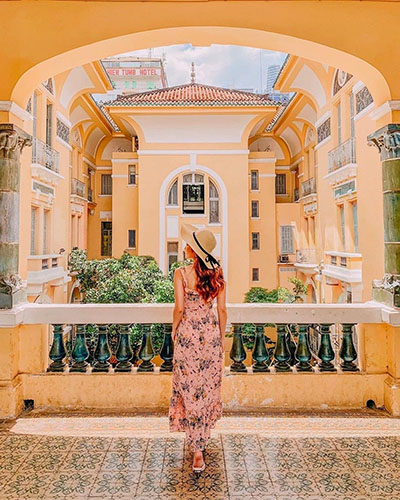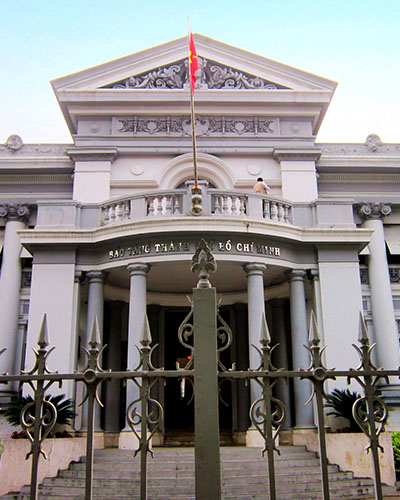Hue Royal Fine Arts Museum
This is the earliest museum established in Hue
This is the earliest museum established in Hue (1923), with the first name being Musée Khai Dinh. After
that, this museum was renamed many times: Hue Museum of Antiquities (1947), Hue Museum (1958), Gallery of
Antiquities (1979), Hue Museum of Antiquities (1992), Royal Fine Arts Museum Hue (1992).
.jpg)
.jpg)
History
The museum's campus is 6,330 square meters, the main building in the middle is 1,185 square meters and some
outbuildings are used as treasures of antiquities and gardens.
The building that was originally Long An Palace in Bao Dinh Palace was moved here in 1909 to house the Tan
Tho Library of Quoc Tu Giam School. In 1923 at the request of the Ancient Citadel of Hieu, this building was
used as Khai Dinh Museum.
Long An is a beautiful wooden structure built in the "duplicate" style with 128 columns. The interior
decoration is extremely rich, artistic and very elegant.
.jpg)
Artifacts in the Museum have been collected and stored since 1913 (when the Ancient Citadel Hieu Hoi was
founded), until 1945, there were about 10,000 items, most of which were furniture, used furniture, and
furniture. used by the court, works of art in the Palace ... in many materials, gold, silver, jade, bronze,
ivory, glass, cloth, paper...
The idea of building the Museum to preserve Champa sculptures had been sparkled since 1902. In particular,
it must highlight the EFEO project with the great contribution of Henri Parmentier, Dean of the Department
of Archeology. After significant effort and determinations, the first building was started constructing in
1915, completed in 1916 and opened to the public in 1919.
.jpg)
In addition, at the museum there is an archive of thousands of artifacts produced by the court on the spot,
or made to order, and ordered as gifts of exceptional sets. An archive of more than 80 Cham artifacts
collected in ancient Chau O and Chau Ly and during an ancient survey at Tra Kieu (1927).
The museum campus is 6,330 m2 wide, including the main building in the middle with an area of 1,185m2 and
a number of outbuildings used to store antiques, a garden,... The main building was originally a palace.
Long An is located in Bao Dinh Palace built in 1845 on the North bank of Ngu Ha. It was a special palace for
King Thieu Tri (1841-1847) to occasionally entertain and rest when he went out to plow the nearby Tich Dien
field. In 1909, during the reign of King Duy Tan, the court moved Long An Palace to the present location to
make the library of the adjacent Quoc Tu Giam school. In 1923, at the request of the Association des Amis du
Vieus Hue, Nam Trieu allowed all documents and books in this library to be moved to a row of houses to the
left of Di Luan Duong in the campus. Quoc Tu Giam school, then gave it the new name Bao Dai library, and the
old Long An palace was used as Musee' Khai Dinh.
.jpg)
The ancients made a lot of sense when using Long An Palace as a museum. This is a beautiful architectural
work of ironwood, built in the unique architectural style of Hue's palace architecture. The temple is made
in the style of "coincidence with snails" with 128 columns. The interior and exterior decoration is
extremely rich, artistic and very elegant.
On the roof and shore, the image of "two dragons painting Chau" and "four spirits: dragon unicorn" are
decorated. Many art researchers have agreed that this is "a magnificent building in the most beautiful class
of Vietnamese palaces.” Thus, Long An Palace alone is already a precious museum artifact.
Most of the artifacts in this museum have been collected and stored from 1913, when the Ancient Capital
Citadel Association began to establish and operate, to March 1945, when the Japanese coup ousted the French.
In Indochina, that academy was also disbanded. At that time, the number of artifacts displayed and stored
here has reached nearly 10,000 units. They are made with all kinds of materials such as gold, silver,
copper, glass, terracotta, stone, wood, rattan, bamboo, cloth, leather, paper, etc. Most of them are
furniture, mandarins, utensils. of the court, the royal family, the works of art were displayed in the
palaces of the Nguyen Dynasty.
.jpg)
Experiencing the destruction of time and the loss due to human greed, the number of antiques there is not
intact as before. But, today, when going there, visitors still admire hundreds of rare and precious
artifacts such as the throne, the king's palanquin, the long floor, the royal physician, the queen's robe,
the queen's comedy, the tea cabinet, the poetry paintings. tabernacle, crockery, silverware, bronze, glaze,
... are displayed in this hall.
Most of them are handicraft products made by the "golden hands" once made by order of the court, or to offer
to the king. They are not mass-produced items, but only one set or one piece each. That's rare and unique.
.jpg)
In addition to the exhibits on display, the museum also stores thousands of other artifacts that were
produced locally, ordered by the court, or purchased from abroad, and brought as gifts by diplomatic
missions. The most abundant here is blue-glazed porcelain, commonly known as "Bleu de Hue'". This is a
"style item" made with high technology, ordered by the Nguyen dynasty to be made from famous ceramic kilns
in China, based on the preferences, designs, and sizes that Vietnamese kings and mandarins have. stated in
the “order”. In the enamelware warehouse, there are also a number of wares made in France, Japan, the UK,
the US....about 100 sets of clothes of kings, queens, princes, mandarins, and soldiers are also being kept
in the warehouse. linens.
In the campus of this museum, there is another warehouse storing more than 80 Cham artifacts collected in
the ancient Chau O and Chau Ly areas, and brought from Tra Kieu during archaeological excavations there in
the past. 1927. Particularly, the Cham artifacts have been evaluated by researchers as rare cultural
heritages not only of the Far East but also of the world. In general, the ancient Long An temple as well as
the artifacts here have a special attraction for domestic and international tourists, in the past, when
visiting the ancient capital.
.jpg)
.jpg)
.jpg)
.jpg)
.jpg)
.jpg)
.jpg)







